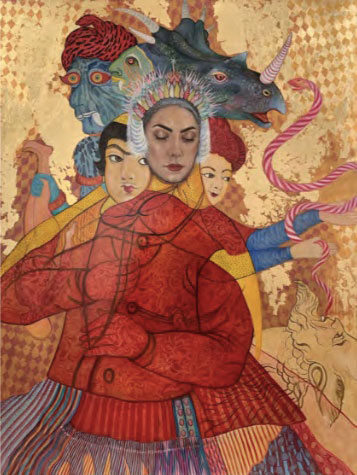- Apply
- Visit
- Request Info
- Give
Published on July 13, 2021
Bahar Sabzevari
Golden Age (2020), a reference to former Persian achievements, shows us Sabzevari with shut eyes, wearing a voluminous red robe. On her left arm, a long, red and white striped viper rises, about to strike, while on top of her head, we find two demons on the left and a gray rhinoceros with a protuberant horn on the right. On both sides of the artist’s head is a face from traditional Persian painting. Here, too, viewers have the sense that the artist is determined, quite literally, not to see the antagonistic forces surrounding her. It is a measure of her strength as a painter that this mixture of the sharply realistic and the imaginatively surreal (yet also faithfully painted) convinces us of a psychic reality that we would be well to take note of, in light of the skill and emotional reach of the imagery. We are living in a time of extraordinary eclecticism, but Sabzevari remains close to her classical ties. The show is particularly interesting as an example of a gifted artist making intelligent use of the past. Sabzevari is a painter of genuine historical achievement, and her conceit of demons jumping out of her head makes her a psychically transparent artist of today. We hope that her insightful mixture of tradition and personal investigation, done so well in this show, continues in the future.
Of the “Crown Series” Sabzevari says, “I think every woman is a queen, which is why in my portraits I depict a crown…My personal story, my experiences in life and my lucid dreams all inform what the crown eventually morphs into.” Drawing from Persian mythology and her love of animals, the crowns can be writhing with colorful, fantastical creatures and deities, as well as figures from Persian literature.
Sabzevari’s self-portraits also explore her own personal stories. The first thing you notice is her gaze – steady and unflinching, though more curious than confrontational. “A direct gaze is considered rude in Eastern culture, especially for women,” she explains. “The women in my work are trying to express their courage and boldness, declaring visually that they are not afraid of being seen or judged. In exchange, the gaze is nonjudgmental and draws the audience closer, inviting them to discover the painting and the idea behind it.”
Jonathan Goodman, Bahar Sabzevari: Gaze and Glance, https://brooklynrail.org/2020/10/artseen/Bahar-Sabzevari-Gaze-and-Glance


